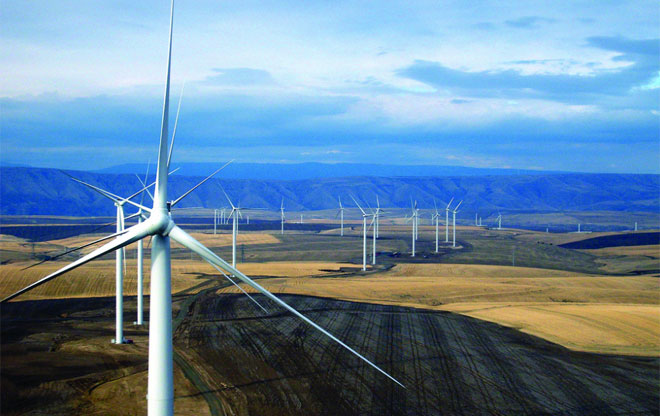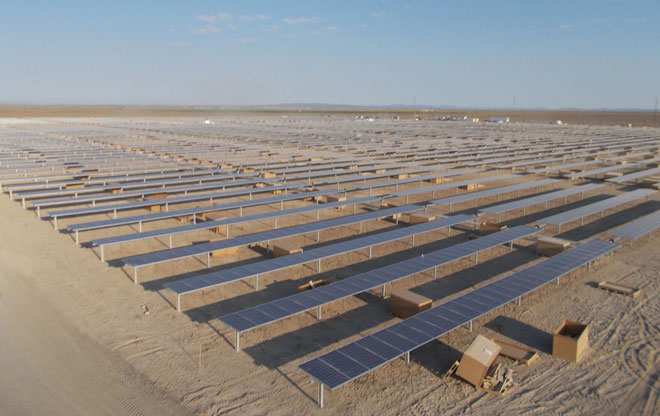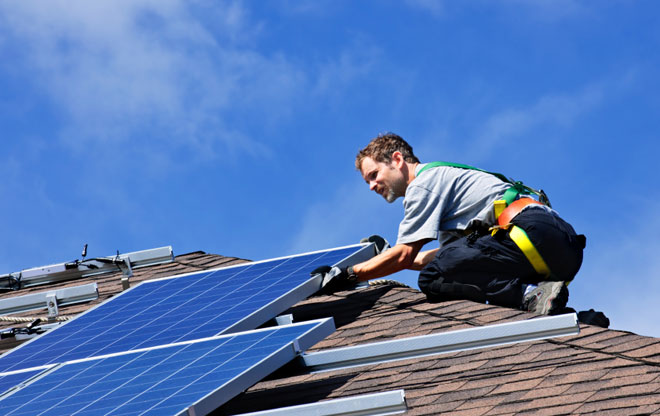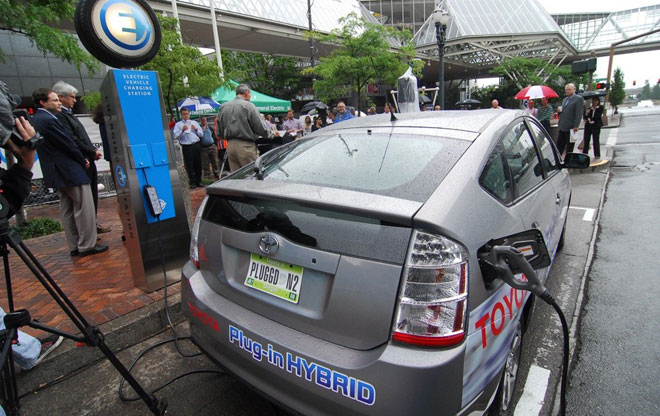
Hydroelectric Power
In 1937, the Bonneville Dam was completed 40 miles east of Portland on the Columbia River. The hydroelectric dam can produce 1.2 gigawatts of electricity. Hydropower depends on precipitation and elevation change to create energy. Oregon’s topography and climate have enabled it to become the second highest hydropower-generating state in the country, behind only Washington. Oregon’s abundant hydroelectric power contributes to residential electricity prices well below the national average.
Image: Kevin Wingert BPA
Growing Wind Capacity
Installed wind power capacity in Oregon has seen large growth in recent years. Climbing from 1 percent of total capacity in the early 2000s, wind power accounted for 12.4 percent of total electricity generated in Oregon in 2013. Most of Oregon’s wind turbines are located in the north central part of the state. Also, Vestas, one of the world's largest wind turbine manufacturers, has its North American headquarters in Portland.
Image: Portland General Electric 
Outback Solar Farm
According to the creators of Outback, which is expected to become the Northwest's largest solar power plant, they are close to 90 percent finished with construction in the high desert east of Christmas Valley. The 5.7 megawatt array of approximately 20,000 solar panels will cover 40 acres near the southern Oregon town. The facility will send power to Portland General Electric customers through the Bonneville Power Administration's transmission system.
Image: Smart Energy Capital 
Residential Solar Incentives
Portland offers residents incentives, including solar rebates, tax credits, property tax exemptions, and net-metering. These incentives have produced more than 1,100 solar installations in the past four years, saving more than 9.8 million kilo-watt-hours of electricity. Through the Oregon Energy Trust, households can get up to $5,000 in rebates for installing solar panels. Residents can also get a $6,000 tax credit. Net-metering enables residents to gain credits for any excess energy generated but not used.
Image: iStockphoto.com 
Regenerative Power
The largest solar project in downtown Portland is a TriMet installation near Portland State University, which generates 67,000 kilowatt-hours of clean energy for the public transportation system. The facility cost $376,000, including $133,200 in grants and rebates. Portland's light rail uses a regenerative braking system. Upon deceleration, the vehicle motors function as generators and make power available to the overhead wires. Approximately 70 percent of this regenerated power is captured and used by nearby trains.
Image: Lloyd Lindley 
Urban Renewable Energy Research
TriMet recently constructed a large steel "drapery" near the Portland State University (PSU) campus, designed to support future wind turbines and solar panels that are part of a renewable energy project. Built with $1.2 million in federal stimulus funds, the steel structure will wrap around several buildings at TriMet's light rail terminus at SW Jackson St. between 5th and 6th avenues.
Image: TriMet
Electric Vehicle Charging Station
Portland benefits from the Electric Vehicle Project, a federally funded initiative that will install over 2,000 charging stations in the Willamette Valley. Of these stations, approximately 1,000 will be accessible to the public. With 11 charging stations per 100,000 residents, Portland has the highest number of hybrid charging stations per capita in the U.S. Local electric energy companies are also testing charging systems. New credits allow for 25 percent of the eligible cost of the vehicle fueling or charging equipment, not to exceed $750.
Image: Earth2Tech
Arcimoto SRK
Portland has a rich "maker" community. Arcimoto, a Portland-based sustainable transportation design and innovation firm, is creating advanced all-electric vehicles for city use. Oregon's electric vehicle firms supports a wider ecosystem of innovation. Drive Oregon writes, "The cluster supports a wide range of jobs and connects with other leading industries, while accelerating the development of a cleaner, more sustainable transportation system."
Image: Arcimoto 
Walking and Biking Means Less Energy Use
Portland has 2,117 miles of sidewalks. According to Metro, walking accounts for 47 million trips, or 28 percent of trips taken by Portlanders each year. Fifteen percent of Portland households don't even own a vehicle. In Portland, 6 percent of commuters bike to work, which is 10 times the national average. We have 319 miles of bikeways, including 59 miles of neighborhood greenways, 181 miles of bike lanes, and 79 miles of bike paths, and are expanding the system each year. There are 5,000 publicly-installed bike racks.
Image: Derrick Coetzee / Flickr